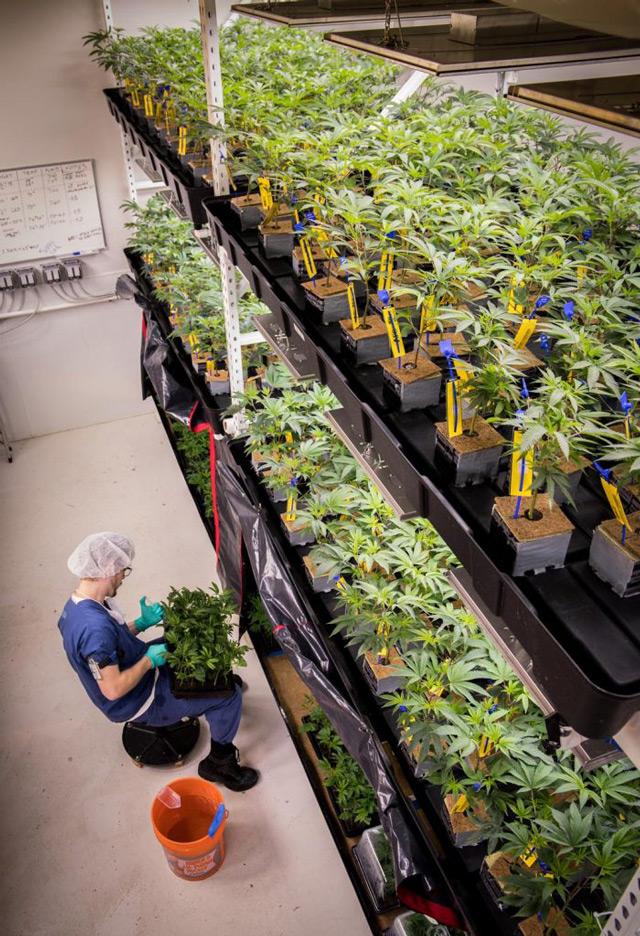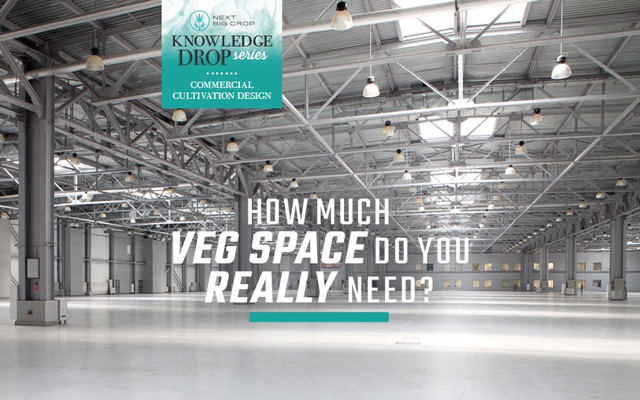By Aaron Mullins—Systems Coordinator, Next Big Crop
How Much Veg Space Do You Really Need?
Whether you are a craft grower or a large-scale cannabis cultivator, every square foot of your facility matters. How much vegetation space you need, therefore, is a critical question—both for ensuring quality and maximizing efficiency. And when determining the amount of veg space you’ll need, you’ll want to look at a few specific guiding factors, including your grow methodology, how many flower rooms you need to feed, cultivation best practices, and state and local regulations.
Regulatory and Methodology Considerations
Your grow methodology will generally dictate how much space you need. If you only have one generation of plants feeding four flower rooms on a two-week veg schedule, that implies a very different setup than if you have eight rooms on a two-week veg schedule, with two generations of plants at any given time.
A lot of it comes down to your plant count, which is often dictated by the state you’re operating in. Regulations in Arkansas, for instance, only allow 150 plants onsite at any given time. In circumstances like this, where you’ll want to get the most out of every plant, it makes sense to vegetate them for 8-12 weeks.
Whereas neighboring Oklahoma has no limit on plant count. Growers in that state are likely running a higher volume and flipping plants over to the flower rooms after two weeks or so. Your plant count will determine the size of your veg rooms as well as the length of time your plants will spend in those veg rooms.
Where are your veg rooms located?
Your grow room setup should be designed to enhance efficiency and protect your mother plants. The flow of your commercial grow setup should always start with the veg rooms. Your vegetation rooms are where you keep your mom plants and produce your clones. If you have the space, you’ll want to separate moms from your clones and from anyone who doesn’t need to be near them. That means having separate veg rooms for moms and clones, if possible, and designing your rooms so employees can pass through the facility without entering the veg rooms, unless they need to.
Sometimes you can make use of your vertical space when you’re running low on horizontal space. Having two or three levels can double or triple your veg space. We don’t advise going above three levels, however, which can slow you down and become a safety concern.

How do I plan lighting for my veg room?
There are many factors to consider when setting up your veg room according to our System Design Manager, Justin Itzkowitz.
Generally, 20% of a single flower room’s light wattage is what’s needed for your veg room. Still, the correct percentage is dependent on several factors. Here are a few questions you need to ask:
- Are you using HPS (High-Pressure Sodium), CMH (Ceramic Metal Halide), or LED fixtures? Or are you using a combination of light fixtures?
- You’ll often see HPS lights used in flower grow rooms because they spread light widely and are relatively inexpensive compared to LEDs. In the same operation, you might see LEDs used in the veg room because they emit less heat and allow for a high-density tiered racking model that minimizes a veg room’s footprint.
- What light models are you using?
- Each fixture style will spread light and consume power differently.
- What’s your growing methodology?
- The appropriate lighting fixture selection depends on your facility design (ex: a veg-in-place model or a handful of flower grow rooms for each veg room or a perpetual harvest model).
Should your veg grow rooms be the same size?
When designing and building out your flower rooms and veg rooms, it’s also important to keep in mind that flower rooms should be a consistent size, so you have a consistent amount of biomass moving through your workflow. Otherwise, managing that biomass can become a much bigger headache than it needs to be.
There is no one right answer for how many veg rooms any grower should have. It largely comes down to your methodology and plant count. Understanding the key variables that go into calculating how many plants you should have in your target amount of veg space is critical to achieving optimal output at your facility.
How many plants can grow in a 10 x 10 room?
The number of plants you can grow in a 10 x 10 room is based on your growing methodology.
Some cultivators prefer to grow large plants, while others prefer small plants. In one tier, you can grow up to 100 plants in a 100 square foot area.
Most cultivators utilize roughly 70% of a room’s floor space as the canopy. In this scenario, a 10 x 10 room can hold up to 70 plants.
Efficient facilities take advantage of tiered growing systems. Each tier increases production capabilities and can triple a room’s canopy.
When you hit three tiers, it’s more cost-effective to increase canopy size in other ways, like additional floors or a larger facility.
Can you veg and flower in the same room?
You can veg and flower plants in the same room, although we don’t recommend the practice for commercial facilities.
Here are a few reasons why:
- Veg plants are significantly smaller than flowering plants. You can store veg plants close together to reduce their overall footprint, which has the added benefit of maximizing light; with a dense canopy, more light hits each plant and reduces electricity consumption.
- Veg and flowering plants have different environmental needs and thrive under different temperature and humidity settings. If you veg and flower in the same room, you’ll need a dehumidification system that covers a wide range of humidity and temperature settings to satisfy the needs of both veg and flowering plants. These systems are more expensive.
- With a designated veg room, you can reduce infrastructure costs by sizing HVAC equipment for the environment.
- In optimized facilities, most of the production space is designated for flowering plants (they produce a sellable product). Designated veg rooms are smaller than flowering rooms – you can use the extra room for additional flowering space.
Have more questions? Contact our Facility Design team

